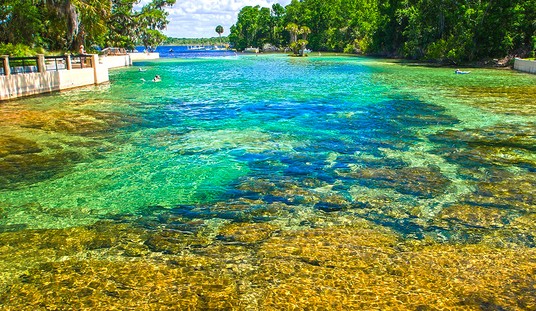The 11:00 AM EDT advisories from the National Hurricane Center are filled with good news, as the trio of storms churning up the Atlantic — Tropical Storm Hanna, Hurricane Ike, and Tropical Storm Josephine — have all weakened a bit in the last six hours, and all are likely to either weaken or hold steady in the short term.
Hanna, for one, is arguably not truly a tropical cyclone anymore, and the odds of it becoming a hurricane seem to have diminished. Ike remains a much more serious threat, as I’ll explain in more detail after discussing Hanna.
* * * * *
Hanna’s top winds have dropped from 70 mph to 65 mph, and although the storm is still officially predicted to reach hurricane strength before tomorrow night’s landfall in the Carolinas, the discussion suggests that such an eventuality has become less likely:
VERY DRY AIR ASSOCIATED WITH THE UPPER-LEVEL LOW OVER THE NORTHWESTERN BAHAMAS IS CHOKING OFF CONVECTION NEAR THE CORE OF HANNA…AND THE CYCLONE HAS A VERY SUBTROPICAL APPEARANCE. CONVECTION HAS DIMINISHED SUBSTANTIALLY OVER THE PAST 6-12 HOURS AND THE HIGHEST FLIGHT-LEVEL AND SFMR WINDS HAVE COME DOWN AS WELL. . . . CONDITIONS ARE NOT CONDUCIVE TO STRENGTHENING RIGHT NOW…WITH MODERATE SOUTHERLY SHEAR AND POOR THERMODYNAMICS. THE GFS SUGGESTS THAT DRY AIR IS LIKELY TO CONTINUE TO BE AN ISSUE UP TO LANDFALL. HOWEVER…AS HANNA AND THE UPPER LOW BEGIN TO SEPARATE SOME OF THE GLOBAL MODELS…INCLUDING THE GFS…SUGGEST THAT THE SHEAR WILL LESSEN SOMEWHAT. THIS WOULD ALLOW FOR SOME INTENSIFICATION…AND SO THE OFFICIAL FORECAST CONTINUES TO SHOW HANNA ATTAINING HURRICANE STRENGTH. THIS IS IN GOOD AGREEMENT WITH THE HWRF…ALTHOUGH THE GFDL AND SHIPS GUIDANCE IS LOWER.
The wind probabilities chart shows that whether Hanna will be a hurricane in 36 hours, just before landfall, is a meteorological coin toss: 50% chance it will, 50% chance it won’t. My gut would put those odds at more like 40%-60%.
It should also be noted that the concept of “landfall” is really rather meaningless, as it was with Fay. As the NHC puts it, “BECAUSE OF THE LARGE…SPRAWLING NATURE OF THE CIRCULATION…THE EXACT TRAJECTORY OF THE CENTER IS RELATIVELY UNIMPORTANT.” The worst weather will be north and east of the center. Hanna will be more like a strongish nor’easter than a major landfalling hurricane.
Indeed, the NHC forecasters are not the only ones to note that Hanna “HAS A VERY SUBTROPICAL APPEARANCE.” Dr. Jeff Masters writes:
Tropical Storm Hanna is a large and very odd looking near-hurricane. In fact, it looks to me like it is more like a subtropical storm than a tropical storm. A subtropical storm tends not to have any heavy thunderstorm activity near its center. Instead, the heaviest rain is located in a band 100 or more miles from the center. Satellite loops show that this is the case with Hanna.
Alan Sullivan is, characteristically, more blunt:
Tropical storm Hanna does not look at all tropical this morning. . . . But there is little convection in Hanna now, and it is widely scattered along an arc that resembles a nor’easter, exactly as I foretold this time yesterday, when I observed the upper low deepening near Hanna. If NHC were truly in the hurricane business, it would deem Hanna extratropical. Even if convection flares anew before Carolina landfall, this will never be a genuine, warm-core tropical cyclone again. . . . For the coast, from the Carolinas northward, this will just be a warm version of a bad winter storm.
Bottom line, Hanna is not worthy of much hype. It will bring rain and storminess to the East Coast, but will hardly be a disaster.
* * * * *
Ike, on the other hand, is most definitely a genuine tropical cyclone, and unquestionably has the potential to be a disaster. But Ike, too, has weakened this morning, from 145 mph to 140 mph. More importantly, it is likely to weaken further, according to the discussion:
IKE CONTINUES TO DISPLAY A WELL-DEFINED EYE WITH VERY COLD CLOUD TEMPERATURES IN THE EYEWALL. HOWEVER THE CLOUD PATTERN IS NOW ASYMMETRIC DUE TO SOME NORTHERLY SHEAR AFFECTING THE CYCLONE. . . . GLOBAL MODELS UNANIMOUSLY INCREASE THE SHEAR OVER IKE AND KEEP STRONG NORTHEASTERLY WINDS NEAR THE CYCLONE FOR THE NEXT FEW DAYS. THIS PATTERN SHOULD INDUCE A STEADY WEAKENING. IN ADDITION…INNER-CORE EYEWALL CYCLES COULD OCCUR…WHICH COULD WEAKEN IKE AS WELL. IN THE LONGER-TERM…THE SHEAR IS FORECAST TO RELAX AND SOME STRENGTHENING COULD OCCUR. HOWEVER…DEPENDING ON THE EXACT TRACK OF IKE…THE HURRICANE COULD BE IMPACTED BY COOLER WATERS NEAR THE SOUTHEASTERN BAHAMAS THAT HAVE BEEN STIRRED UP BY HANNA. THE OFFICIAL FORECAST IS LOWER THAN THE PREVIOUS ONE BUT STILL SHOWS IKE AS A POWERFUL HURRICANE THROUGHOUT THE PERIOD.
Specifically, the forecast calls for Ike to eventually restrengthen “only” to 115 mph, not 130 mph. And it sounds like the NHC thinks even that forecast might be a bit high, especially if Ike tracks into the southeastern Bahamas — which, as it happens, would be the most ominous track in terms of a potential U.S. landfall. In other words, the more likely Ike is to threaten land, the less likely it is to be a monster hurricane in five days. That’s a pretty good trade-off.
That said, there’s still time for additional strengthening even after the end of the five-day forecast — and furthermore, let’s not forget how poor our intensity-forecast skill is. Without question, Ike remains a serious threat. Blogging from his perch in South Florida, the usually hype-averse Sullivan writes that he has “a really bad feeling about Ike”:
[Ike] has overtaken Hanna’s outflow, and it is visibly weakening in the latest images. I would expect a significantly diminished Ike through the next day, with winds dropping under 110 mph by tomorrow. Ike’s course has also shifted more northwest. I am glad to see Ike gain latitude, but I am not confident that the storm will fail to dip back [south] again, as the offshore wind environment is shifting very rapidly. When a west or west southwest course sets up, Ike may also regain major hurricane status. This will be a very dangerous onset for the East Coast. Ike could make landfall anywhere from the Florida Keys to New England, depending on the exact time and pace of its recurvature, which is impossible to foretell at present.
Bottom line: I have a really bad feeling about Ike. Its early symmetry foretold rapid intensification. Its predecessor Hanna remains fairly weak, and will not use much of the available energy in waters off the eastern US. Ike is likely to strike some part of the eastern US with category three force or worse. Offshore recurvature is unlikely, though not beyond hope.
The Houston Chronicle‘s Eric Berger, meanwhile, looks at three Ike scenarios in some more detail:
1. South Florida strike: I spoke with a hurricane scientist I know in Miami yesterday and he was quite concerned about this possibility. The models certainly support this, and the heat potential of the waters near the Bahamas and Florida is quite high enough to support a major hurricane.
2. Re-Curve into the Atlantic: The GFS model has been advertising this solution for a couple of days now. The Bahamas would still likely get hammered, but the mainland United States would be spared. This scenario is most consistent with the climatology outlined below.
3. Northeast U.S. Coast: As bad as a strike on Miami would be, a strike on New York is worse. (How do you evacuate 4 million people from New York?). A major hurricane striking New York remains a low threat, high consequence scenario, even with Ike. But the climatology below suggests it’s possible, and some models have been hinting at such a scenario.
One of the inevitable problems with the New York scenario (in any storm, not just Ike) is that, because a hurricane threatening the Northeast will almost by definition be moving very fast by the time it gets there, any potential NYC evacuation would have to be ordered when the storm is still ridiculously far away — like, down by Florida or Georgia — and when the forecast track is necessarily still subject to enormous errors, due to the distance and the oblique angle of approach. Once the storm is accelerating past the Carolinas and the Delmarva, it’s already too late to order big-city evacuations in the Northeast.
Anyway, “low threat, high consequence” is right. The odds of a disastrous New York landfall are always very low, as the conditions must line up just so — like threading a needle. But someday it’ll happen, and it’ll be bad. Here’s hoping “someday” isn’t next week!
Anyway, Dr. Masters discusses the various Ike scenarios in more detail; read the whole thing. And for what it’s worth, here’s the official forecast. But, as Sullivan, Berger, Masters and the NHC all say, it’s just too early to know where this thing will go.
* * * * *
Last and least, Josephine, which continues to look like a “fish” storm — i.e., one that will stay safely out at sea — has weakened from 60 mph to 50 mph. That’s not as drastic as it might sound; because of the way the NHC rounds to the nearest 5 mph when it converts knots to miles-per-hour, there is no such thing as a 55 mph tropical storm.
However, as with Ike, this morning’s slight downgrade portends further weakening in the short term. The discussion notes that wind shear has blown away Josephine’s convection, exposing its center, and this shear is likely to continue for the next 36-48 hours. In addition, the water underneath Josephine is about to get cooler.
If Josephine survives the next two days, she may get stronger again, as shear may decrease and the storm will move back over warmer water. But, as I said, this storm is probably a “fish,” so my attention will remain squarely focused on Hanna and Ike for the moment.
I’ll be pretty busy this evening, liveblogging John McCain’s acceptance speech over on my other blog. But I will try to post at least one brief evening update here, particularly if anything major changes with Hanna or Ike. In the mean time, as always, you can get the latest official information from the NHC website, and the latest analysis from the weatherbloggers linked in my sidebar at right. Particularly worth waiting for is Dr. Masters‘s afternoon update.








Join the conversation as a VIP Member